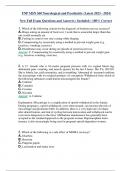Summary
Summary of Media Today by Joseph Turow - Media Platforms and Industries I
- Course
- Institution
- Book
All chapters of each week are concisely written to enhance your understanding, it also has sample answers from each week literature assignment
[Show more]





